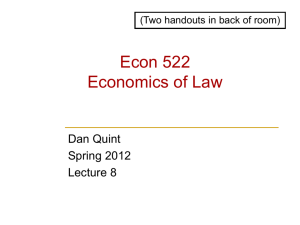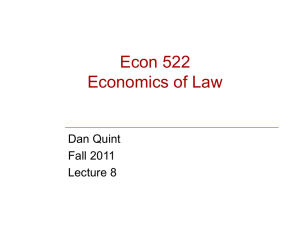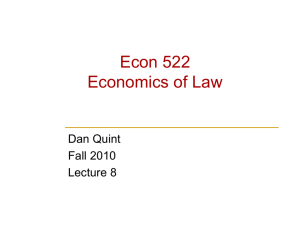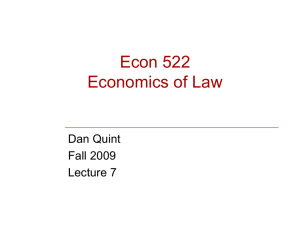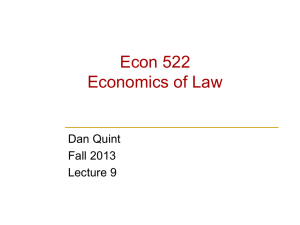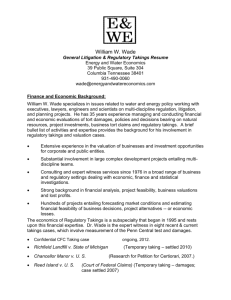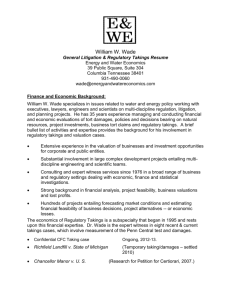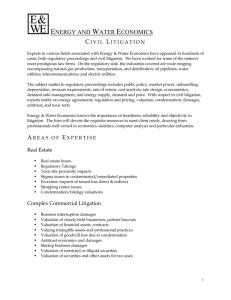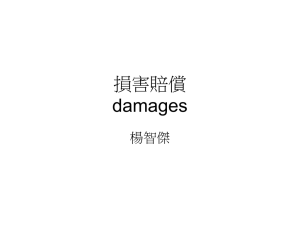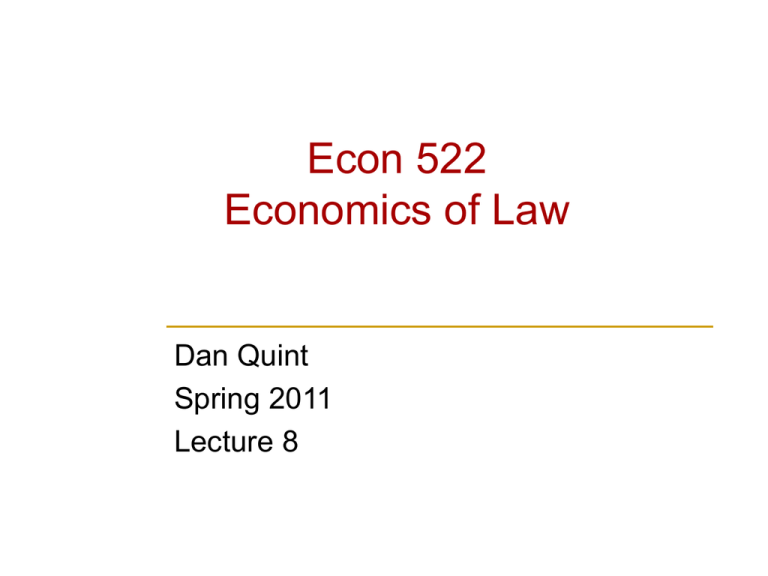
Econ 522
Economics of Law
Dan Quint
Spring 2011
Lecture 8
Logistics
Second homework due next Thursday (Feb 24)
First midterm in two weeks (March 2)
1
How do you establish, verify,
or give up property rights?
2
Fugitive property
Hammonds v. Central
Kentucky Natural Gas Co.
Central Kentucky leased
tracts of land above natural
gas deposits
But geological dome lay
partly under Hammonds’
land
Hammonds sued, claiming
some of the gas they were
extracting was his
(Anybody see “There Will
Be Blood”?)
3
Two principles for establishing ownership
First Possession
fugitive property belongs to nobody until someone extracts it,
establishing ownership
Central Kentucky would own all the gas, since they were first to
actually possess it
Tied Ownership
ownership of fugitive property is tied to something else which is
easier to establish – in this case, surface of the land
Hammonds would own some of the gas, since it was located under
his land
principle of accession – a new thing is owned by the owner of the
proximate or prominent property
4
First Possession versus Tied Ownership
First Possession
simpler to apply – easy to determine who possessed property first
incentive to invest too much to early in order to establish ownership
example: $100 of gas, two companies drilling fast or slow
drilling slowly costs $5, drilling fast costs $25
drill same speed each gets half the gas, one drills fast 75/25
Firm 2
Firm 1
Slow
Fast
Slow
45, 45
20, 50
Fast
50, 20
25, 25
5
First Possession versus Tied Ownership
First Possession
simpler to apply – easy to determine who possessed property first
incentive to invest too much to early in order to establish ownership
Tied Ownership
encourages efficient use of the resource
2
but, difficulty of establishing andFirm
verifying
ownership rights
Firm 1
Slow
Fast
Slow
45, 45
45, 25
Fast
25, 45
25, 25
6
This brings us to the following tradeoff:
Rules that link ownership to possession have the
advantage of being easy to administer,
and the disadvantage of providing incentives for
uneconomic investment in possessory acts.
Rules that allow ownership without possession have
the advantage of avoiding preemptive investment
and the disadvantage of being costly to administer.
7
A nice historical example: the Homestead
Act of 1862
Meant to encourage settlement of the Western U.S.
Citizens could acquire 160 acres of land for free, provided
head of a family or 21 years old
“for the purpose of actual cultivation, and not… for the use or
benefit of someone else”
had to live on the claim for 6 months and make “suitable”
improvements
Basically a first possession rule for land – by living on the
land, you gained ownership of it
Friedman: caused people to spend inefficiently much to
gain ownership of the land
8
Friedman on the Homestead Act of 1862
“The year is 1862; the piece of land we are considering is…
too far from railroads, feed stores, and other people to be
cultivated at a profit.
…The efficient rule would be to start farming the land the first
year that doing so becomes profitable, say 1890. But if you
set out to homestead the land in 1890, you will get an
unpleasant surprise: someone else is already there.
…If you want to get the land you will have to come early. By
farming it at a loss for a few years you can acquire the right to
farm it thereafter at a profit.
9
Friedman on the Homestead Act of 1862
How early will you have to come?
Assume the value of the land in 1890 is going to be $20,000,
representing the present value of the profit that can be made by
farming it from then on. Further assume that the loss from farming it
earlier than that is $1,000 a year.
If you try to homestead it in 1880, you again find the land already
taken. Someone who homesteads in 1880 pays $10,000 in losses
for $20,000 in real estate – not as good as getting it for free, but still
an attractive deal.
…The land will be claimed about 1870, just early enough so that the
losses in the early years balance the later gains.
It follows that the effect of the Homestead Act was to wipe out, in
costs of premature farming, a large part of the land value of the
United States.”
10
When should resources become privately
owned?
First Possession and Tied Ownership are doctrines for how
ownership rights are determined
Next question: when should a resource become privately
owned?
Cost of private ownership: owners must take steps to make the
resource excludable – boundary maintenance
Cost of public ownership: congestion and overuse
An economically rational society will privatize a resource at the
point in time where boundary maintenance costs less than the
waste from overuse of the resource.
11
When should resources become privately
owned?
First Possession and Tied Ownership are doctrines for how
ownership rights are determined
Next question: when should a resource become privately
owned?
Cost of private ownership: owners must take steps to make the
resource excludable – boundary maintenance
Cost of public ownership: congestion and overuse
An economically rational society will privatize a resource at the
point in time where boundary maintenance costs less than the
waste from overuse of the resource.
(either because congestion got worse…
or because boundary maintenance became cheaper)
12
How do you prove ownership of something?
Branding cattle
Vehicle ID numbers
on cars
States grant deeds for
property, and keep
registry of legal owner
13
How do you prove ownership of something?
Branding cattle
Vehicle ID numbers
on cars
States grant deeds for
property, and keep
registry of legal owner
No such system for apples
Too many apples – high cost of maintaining a registry
Apples inexpensive – not much of a problem
14
How do you give up (or lose) property
rights?
Adverse Possession (“squatter’s rights”)
If you occupy someone else’s property for long enough, you
become the legal owner, provided:
1. the occupation was adverse to the owner’s interests, and
2. the owner did not object or take legal action
15
How do you give up (or lose) property
rights?
Adverse Possession (“squatter’s rights”)
If you occupy someone else’s property for long enough, you
become the legal owner, provided:
1. the occupation was adverse to the owner’s interests, and
2. the owner did not object or take legal action
Pro: clear up uncertainty over time; allow land to be put to use
Con: owners must incur monitoring costs to protect property
16
How do you give up (or lose) property
rights?
Adverse Possession (“squatter’s rights”)
If you occupy someone else’s property for long enough, you
become the legal owner, provided:
1. the occupation was adverse to the owner’s interests, and
2. the owner did not object or take legal action
Pro: clear up uncertainty over time; allow land to be put to use
Con: owners must incur monitoring costs to protect property
Estray statutes – laws governing lost and found property
17
Remedies
18
Remedies (review)
Maximum liberty: owner can do whatever he/she wants,
as long as it doesn’t interfere with another’s property
When it does interfere, externality, or nuisance
Affects small number: private externality, or private bad
Transaction costs low injunctions preferable
Affects large number: public externality, or public bad
Transaction costs high damages preferable
19
Types of damages
Compensatory Damages
intended to “make the victim whole”
compensate for actual harm done
make victim as well off as before
Can be…
Temporary – compensate for harms that have already occurred
Permanent – also cover present value of anticipated future harm
20
Temporary versus permanent damages
Temporary damages
Require victim to keep returning to court if harm continues
Create an incentive to reduce harm in the future
Permanent damages
One-time, permanent fix
No incentive to reduce harm as technology makes it easier
21
Efficient nuisance remedies
If a nuisance affects a small number of people (private
nuisance), an injunction is more efficient
If a nuisance affects a large number of people (public
nuisance), damages are more efficient
If damages are easy to measure and innovation occurs rapidly,
temporary damages are more efficient
If damages are difficult/costly to measure and innovation
occurs slowly, permanent damages are more efficient
What’s done in practice for public nuisances?
temporary damages and injunction against future harm
but…
22
Boomer v Atlantic Cement Co
(NY Ct of Appeals, 1970)
Atlantic owned large cement plant near Albany
dirt, smoke, vibration
neighbors sued
plant was found to be a nuisance, court awarded damages
neighbors appealed, requesting an injunction
Court ruled that…
yes, this was a valid nuisance case
and yes, nuisances are generally remedied with injunctions
but harm of closing the plant was so much bigger than level of
damage done that court would not issue an injunction
ordered permanent damages, paid “as servitude to the land”
23
Boomer v Atlantic Cement Co
(NY Ct of Appeals, 1970)
Atlantic owned large cement plant near Albany
dirt, smoke, vibration
neighbors sued
plant was found to be a nuisance, court awarded damages
neighbors appealed, requesting an injunction
Court ruled that…
yes, this was a valid nuisance case
and yes, nuisances are generally remedied with injunctions
but harm of closing the plant was so much bigger than level of
damage done that court would not issue an injunction
ordered permanent damages, paid “as servitude to the land”
24
Limitations and Exceptions to
Property Rights
25
Private Necessity
Property rights generally protected by injunctive relief,
BUT…
Ploof v. Putnam (Sup. Ct. of Vermont, 1908)
Ploof sailing with family on Lake Champlain, storm came up
Tied up to pier on island owned by Putnam
Putnam’s employee cut the boat loose, Ploof sued
Court sided with Ploof: private necessity is an exception to the
general rule of trespass
In an emergency, OK to violate someone else’s property
rights; still must reimburse them for any damage done 26
Private Necessity
Property rights generally protected by injunctive relief,
BUT…
Ploof v. Putnam (Sup. Ct. of Vermont, 1908)
Ploof sailing with family on Lake Champlain, storm came up
Tied up to pier on island owned by Putnam
Putnam’s employee cut the boat loose, Ploof sued
Court sided with Ploof: private necessity is an exception to the
general rule of trespass
In an emergency, OK to violate someone else’s property
rights; still must reimburse them for any damage done 27
Another limitation: determining what
happens to your stuff after you die
Owners today control who inherits their property
Wasn’t always the case
Limitations on who inherits lead to…
Circumvention costs
28
Another limitation: determining what
happens to your stuff after you die
Owners today control who inherits their property
Wasn’t always the case
Limitations on who inherits lead to…
Circumvention costs
Depletion costs
29
Another limitation: determining what
happens to your stuff after you die
Owners today control who inherits their property
Wasn’t always the case
Limitations on who inherits lead to…
Circumvention costs
Depletion costs
Restrictions I place on how they can use it
Impossible circumvention and depletion costs
Allowed difficult to maintain efficiency in changing circumstances
30
Another limitation: determining what
happens to your stuff after you die
Owners today control who inherits their property
Wasn’t always the case
Limitations on who inherits lead to…
Circumvention costs
Depletion costs
Restrictions I place on how they can use it
Impossible circumvention and depletion costs
Allowed difficult to maintain efficiency in changing circumstances
“Restraints on alienation”
Common law generally prohibits perpetuities
Restrictions limited to “lives-in-being plus 21 years”
31
Another limitation: Inalienability
Three ways to protect an entitlement:
as property (through injunction)
by liability rule (through damages)
through inalienability
Lots of things that can’t be bought/sold:
organs
sex
heroin
children
atomic weapons
human rights
Arguments in favor of inalienability…
32
Another limitation: Unbundling
Property: “a bundle of rights”
Can you unbundle them?
Separate them, sell some and keep others
Usually, no
Prohibition on perpetuities
I can’t separate the right to own/live on my land from the right to sell
it or turn it into a golf course
But in some instances, yes…
33
Example of unbundling: Pennsylvania and
coal
Land ownership consisted of
three separable pieces
(“estates”)
Surface estate
Support estate
Mineral estate
34
Unbundling
Free unbundling of property rights generally not allowed
Civil law more restrictive than common law
For efficiency…
In general, efficiency favors more complete property rights
People would only choose to unbundle property when that
increases its value, so we should allow it?
But unbundling might increase transaction costs
Increases uncertainty about rights
May increase number of parties involved in future transactions
35
Two other ways in which property rights are
limited
The government can take your property
“Eminent domain”
And the government can tell you what to do with it
Regulation
We’ll discuss these on Monday
36
Takings
(doubt we’ll get to here)
37
Takings
One role of government: provide public goods
When public goods are privately provided undersupply
Defense, roads and infrastructure, public parks, art, science…
To do this, government needs land
(which might already belong to someone else)
In most countries, government has right of eminent domain
Right to seize private property when the owner doesn’t want to sell
This type of seizure also called a taking
38
Takings
U.S. Constitution, Fifth Amendment: “…nor shall private
property be taken for public use, without just
compensation.”
Government can only seize private property for public use
And only with just compensation
Consistently interpreted to mean fair market value – what the owner
would likely have been able to sell the property for
39
Takings
Why allow takings?
40
Takings
Why allow takings?
Why these limitations?
why require compensation?
41
Takings
Why allow takings?
Why these limitations?
why require compensation?
$10 MM
$9 MM
$3 MM
$1 MM
42
Takings
Why allow takings?
Why these limitations?
why require compensation?
why only for public use?
43
Takings
Why allow takings?
Why these limitations?
why require compensation?
why only for public use?
The government should only take private property (with
compensation) to provide a public good when transaction
costs preclude purchasing the necessary property
through voluntary negotiations
44
Poletown Neighborhood Council v Detroit
1981: GM was threatening to close Detroit plant
Would cost city 6,000 jobs, millions in tax revenue
City used eminent domain to condemn entire neighborhood
1,000 homeowners and 100 businesses forced to sell
land then used for upgraded plant for GM
city claimed employment and tax revenues were public goods,
which justified use of eminent domain
Mich Sup Ct: “Alleviating unemployment and revitalizing the
economic base of the community” valid public purposes;
“the benefit to a private interest is merely incidental”
Overturned in 2004 ruling (Wayne v Hathcock)
Similar case, Kelo v. City of New London (2005 US Sup Ct)
45
Poletown Neighborhood Council v Detroit
1981: GM was threatening to close Detroit plant
Would cost city 6,000 jobs, millions in tax revenue
City used eminent domain to condemn entire neighborhood
1,000 homeowners and 100 businesses forced to sell
land then used for upgraded plant for GM
city claimed employment and tax revenues were public goods,
which justified use of eminent domain
Mich Sup Ct: “Alleviating unemployment and revitalizing the
economic base of the community” valid public purposes;
“the benefit to a private interest is merely incidental”
Overturned in 2004 ruling (Wayne v Hathcock)
Similar case, Kelo v. City of New London (2005 US Sup Ct)
46

